I last wrote about the Vanguard International Dividend Appreciation Index Fund ETF Shares (NASDAQ:VIGI), a simple international equity dividend growth index ETF, last year. In that article, I argued that VIGI’s cheap valuation and strong dividend growth track-record made the fund a buy. I also argued that the Vanguard International High Dividend Yield Index Fund ETF Shares (VYMI) provided a similar, but broadly superior choice. Since then, both VIGI and VYMI have very slightly outperformed the S&P 500, but VYMI’s performance has been a tad stronger. Results have been broadly in-line with expectations, if mostly average.
Since my last article, VIGI’s valuation has become pricier, and the U.S. dollar has lost some strength. These issues, combined with VIGI’s disadvantages relative to peers, have made me re-assess the merits of the fund. Right now, I would not be investing in the fund.
VIGI – Basics
- Sponsor: Vanguard
- Underlying Index: S&P Global Ex-U.S. Dividend Growers Index
- Dividend Yield: 2.16%
- Expense Ratio: 0.15%
- Total Returns CAGR (Inception): 8.6%
VIGI – Overview and Analysis
Index and Holdings
VIGI is an international dividend growth index ETF. It tracks the S&P Global Ex-U.S. Dividend Growers Index, an index of these same securities. Said index includes all international stocks with at least 7 consecutive years of dividend growth, subject to a basic set of inclusion and exclusion criteria. It is a market-capitalization weighted index, although weights are capped at 4.0% to ensure diversification.
VIGI’s underlying index is quite broad, which results in a well-diversified fund. VIGI currently invests in 325 stocks, about average for a diversified equity fund.
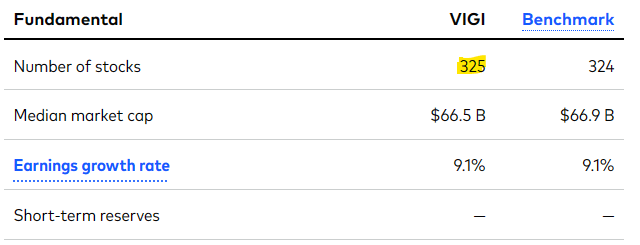
VIGI
VIGI invests in dozens of countries, but clearly focusing on developed European and Asian markets.
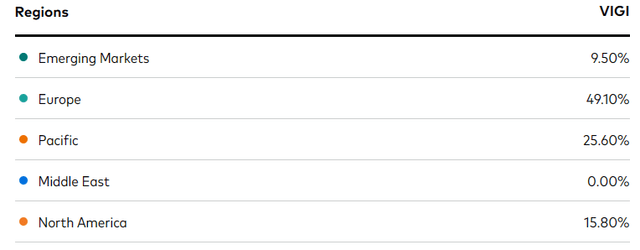
VIGI
VIGI’s developed market holdings are of comparable risk to average U.S. equities. VIGI’s emerging market holdings, however, are materially riskier. As the latter are only a small portion of the fund’s portfolio, the fund should be a bit riskier than the average U.S. equity index fund. VIGI saw slightly higher losses than the S&P 500 during 1H2020, the onset of the coronavirus pandemic. Results were as expected, although not all that significant.

Data by YCharts
VIGI provides investors with diversified industry exposures as well. Allocations to real estate and utilities are both quite low, however.
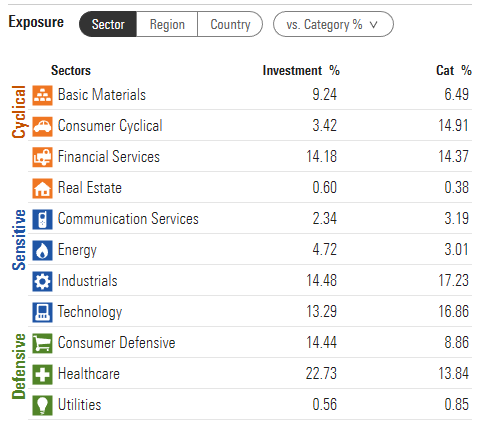
Morningstar
As is the case for most dividend ETFs, the fund is underweight tech and growth, while being overweight old-economy industries like materials and industrials. Compare VIGI’s industry allocations to those of the S&P 500, for instance.
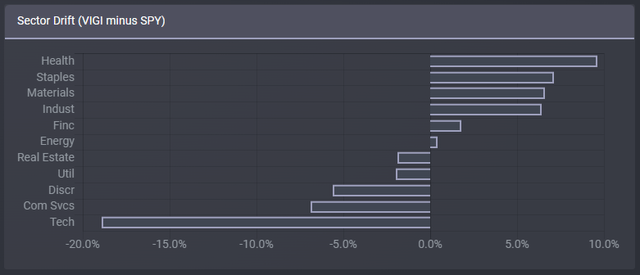
VIGI
VIGI’s industry exposures seem to have a small, but noticeable, impact on the fund’s performance. VIGI tends to outperform when tech underperforms, as was the case in 2022.
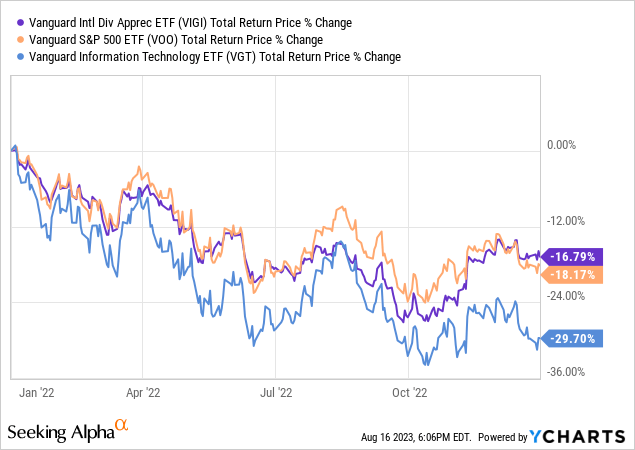
Data by YCharts
At the same time, VIGI tends to underperform when tech outperforms, as was the case in 2020.

Data by YCharts
Although VIGI’s differing industry exposures do seem to have an impact on the fund’s performance, it seems to be quite small.
Besides the above, not much else stands out about the fund, its index, or its holdings. It is a simple international equity index ETF, focusing on developed markets, with a value tilt.
Dividend Analysis
VIGI invests in international stocks with long track-records of consistent dividend growth. This should result in good, above-average, long-term dividend growth for the fund, as seems to be the case. VIGI’s dividends have grown at a 7.4% CAGR for the past five years, rising to 14.4% these past twelve months. Growth is higher than most broad-based equity indexes, including those investing in global and U.S. equities, as well as those focusing on dividend stocks. Table below excludes a special distribution in late 2022.

Seeking Alpha – Chart by Author
Although VIGI’s dividend growth track-record is quite good, the fund sports a mediocre 2.2% dividend yield. Such a low starting yield blunts the effectiveness of the fund’s dividend growth and means even long-term investors are likely to receive meager dividends from their investment in VIGI. As an example, the fund sports a 5Y yield on cost of only 2.5%, rising to 2.8% at the 7Y mark. Both are very low figures, and only available to long-term investors.

Seeking Alpha – Chart by Author
There are many ETFs with broadly stronger dividends than VIGI.
As an example, the Vanguard International High Dividend Yield Index Fund ETF Shares (VYMI) yields 4.6% and sports a 7Y yield on cost of 5.2%. Both figures are much higher, almost twice, than VIGI’s.

Seeking Alpha – Chart by Author
As another example, the Schwab U.S. Dividend Equity ETF (SCHD) yields 3.5%, and has a 7Y yield on cost of 6.1%. Both figures are higher than VIGI’s, especially the yield on costs and (implied) dividend growth rates.
Although VIGI’s dividend growth track-record is quite strong, the fund’s 2.2% dividend yield is very weak, and the fund’s dividends are, overall, weak as well.
Valuation Analysis
VIGI is an international equity ETF, and international equities currently trade with very discounted valuations, on both PE and dividend yield metrics.
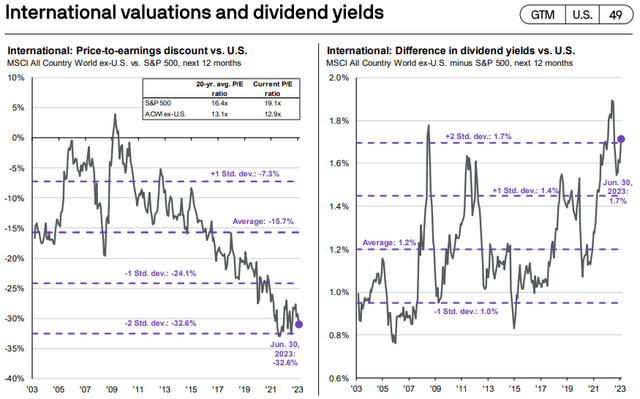
JPMorgan Guide to the Markets
VIGI itself, on the other hand, trades with a slightly cheaper valuation than broad-based U.S. equity indexes, but at a premium relative to global equities, and both U.S. and international dividend equities.
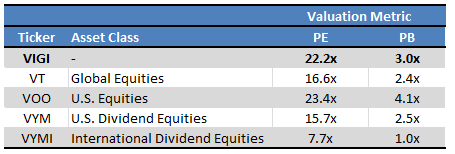
Fund Filings – Chart by Author
Although VIGI does trade at a slight discount to most U.S. equities, the fund’s valuation seems quite expensive (or less cheap) overall. The comparison to the Vanguard International High Dividend Yield Index Fund is particularly jarring: VIGI is about 3x more expensive than VYMI. Both funds focus on dividend-paying international stocks too.
Performance Analysis
VIGI’s performance track-record is below-average, at best, with the fund generally underperforming relative to most relevant equity indexes.

Seeking Alpha – Chart by Author
Performance relative to U.S. equity indexes is particularly poor, owing to U.S. equity outperformance these past few years.
Performance was reasonably strong on the 1Y mark, owing to weaker dollar prices / stronger foreign currency prices. VYMI’s performance was even stronger, however.
Performance compares somewhat reasonably to VYMI long-term, but this is partly a timing issue: VYMI’s share price was particularly high five years ago exactly, so fund performance looks quite bad at the 5Y mark.
Overall, VIGI’s performance track-record is quite poor, although it does not seem terrible enough to constitute a deal-breaker.
Conclusion
VIGI offers investors a strong dividend growth-track record, but a mediocre 2.2% yield, and below-average performance track-record. VIGI offers investors few benefits but has several important downsides. As such, I would not be investing in the fund at the present time.
Read the full article here











